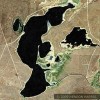
Shamanism or Shamanistic
Posted on Thursday, September 23rd, 2010
“Shamanism is an anthropological term referencing a range of beliefs and practices regarding communication with the spiritual world. A practitioner of shamanism is known as a shaman”.
I started researching this topic because I was looking for the explanation for the geoglyphs I was locating around the Western United States. My inquiries into this subject lead me to discover that these geoglyphs were likely totems and that these totems were tied into a belief system that goes back into the earliest days of human history. This belief system has been called several names such as polytheism, pantheism, paganism and today is known to cultural anthropologists as Shamanism. Shamanism is not an organized religion with a religious head or a divinity school. However, it has spread over the millennia to all the continents occupied by mankind. It is found in indigenous tribes all over the world in very different cultures. Some anthropologists such as Alice Kehoe state that the term Shamanism is misleading because it is so diverse. Perhaps the more appropriate word is “Shamanistic” because all Shamanistic cultures are not identical to each other  but simply share some common elements of a belief system that unites them with all the other Shamanistic cultures.
These common elements of Shamanism include:
1) Drums             2) Feathers        3) Dancing         4) Shaking
5) Rattles            6) Gongs           7) Pipes            8) Swords
9) Totem Images 10) Head Dress   11) Holy Stick
As I have studied this topic I have been surprised to find out not only how far back in time this belief system goes (including Baal in the Middle East) but also how widely it has spread around the world. I use the word spread because I believe that its hardly possible for these almost identical belief symbols and patterns to have sprung up spontaneously around the world. I believe that a far more plausible explanation is that these beliefs were “cross pollinated” into these different cultures by business, cultural and religious exchanges between these ancient people. If this is true then it means that the ancients traveled far more and further than we currently believe.
The most current example of a “Shamanistic” society is the fictional tribe in the movie Avatar. The father of the principal female in the story was the tribal chief. Her mother was the shaman or spiritual leader. Avatar does a good job of giving the viewer an insight into the shamanistic culture against a backdrop of a fictional world of flying dragons etc. Noteworthy examples are the comments regarding the “tree of souls” being connected to every other tree physically as well as spiritually, the prayful apology for the taking of any life form and the literal spiritual and physical connection between the horse and rider, rider and dragon etc. This story is a simplistic generalization of what shamanism is about but it does give a good overview.
Quotes from Wikipedia Re: Shamanism
- Shamans gain knowledge and the power to heal by entering into the spiritual world or dimension. The shaman may have, or acquire many spirit guides in the spirit world, these often guide and direct the shaman in his/her travels. (Pg 3of 31)
- The use of totemic items such as rocks with special powers and an animating spirit is common.  Such practices are presumably very ancient. (Pg 6 of 31)
- The shaman knows the culture of his or her community well, and acts accordingly. Thus, their audience knows the used symbols and meanings—that is why shamanism can be efficient; people in the audience trust it. (pg 7 of 31)
- Shamanic practices may originate as early as the paleolithic, predating all organized religions, and certainly as early as Neolithic period. (pg 10 of 31)
- Today, shamanism survives primarily among indigenous peoples. Shamanic practices continue today in the tundras, jungles, deserts, and other rural areas, and even in cities, towns, suburbs, and shantytowns all over the world. (Pg 12 of 31)
- Siberia is regarded as the locus classicus of shamanism. It is inhabited by many different ethnic groups. Many of its Uralic, Altaic, and Paleosiberian peoples observe shamanistic practices even in modern times. Many classical ethnographic sources of “shamanism” were recorded among Siberian peoples. (Pg 13 of 31)
- Chinese shamanism has the longest recorded history in the world. The word wu “shaman; spirit medium; healer” first appreared on oracle bones from the late Shang Dynasty (c. 1600-1046 BCE). (Pg 14 of 31)
- Eskimo groups comprise a huge area stretching from Eastern Siberia through Alaska and Northern Canada (including Labrador Peninsula) to Greenland. Shamanistic practice and beliefs have been recorded at several parts of this vast area crosscutting continental borders. (Pg 16 of 31)
Chinese Totem Poles
Medicine Men, Witch Doctors And Shaman
Google: “First Look: The Qiang People of Sichuan”by Emma Zevik, Ph.D. (pages 195-206),“The Qiang live in stone-fortress homes built on the mountain cliffs” page 198. Not unlike the Anasazis of ancient America who were cliff dwellers.
I am not promoting Shamanism or recommending it to others. The reason I am spending time on this topic is to increase our mutual understanding of this belief system, to show how important it was to the ancients and thus demonstrate why then they would spend so much time, effort and resources on building the massive geoglyphs found in North America and elsewhere.
In this blog I made the connection between geoglyphs and totems several weeks ago. As I was “googling” totem poles amd totem images all around the Pacific Rim and seeing all the material that had been posted I realized that totems and totem poles were a common denominator in all the Pacific Rim countries. Totems are a central element in Shamanistic cultures. Then I understood that all these cultures have ancient Shamanism in common.
The Beak of the 10th Sun Raven STILL GLOWS!

















